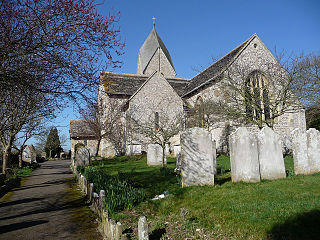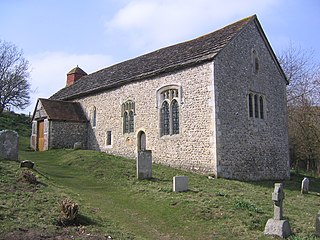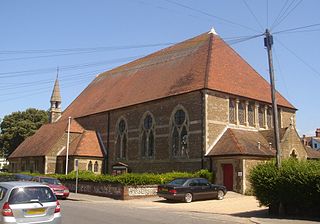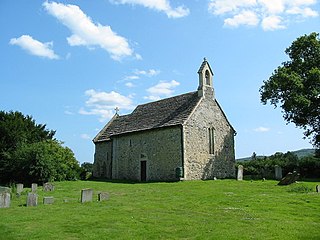Kingston by Sea, also known as Kingston Buci, Kingston Bucii or simply Kingston, is a small area in the Adur district of West Sussex, England. Although it is now part of a continuous urban area, its origins lay in an ancient village and parish church between Southwick to the east, Shoreham-by-Sea to the west and the mouth of the River Adur to the south. St Julian's Church survives, and its parish perpetuates the ancient "Kingston Buci" name.

St. Mary's Church, Broadwater, is a Church of England parish church in the Worthing Deanery of the Diocese of Chichester. It serves the ecclesiastical parish of Broadwater, West Sussex and is named after St. Mary. St Mary's is one of several sites in this benefice along with Queen Street and St. Stephen's.

St Nicolas Church is an Anglican church in the Portslade area of the English city of Brighton and Hove. It has 12th-century origins, and serves the old village of Portslade, inland from the mostly 19th-century Portslade-by-Sea area.

St Margaret's Church is an Anglican church in the Ifield neighbourhood of Crawley, a town and borough in West Sussex, England. It is the ancient parish church of the village of Ifield; the medieval settlement was expanded to form one of the New Town of Crawley's 13 neighbourhoods, and the church's modern parish now serves several other neighbourhoods as well.

The Church of St Mary the Blessed Virgin, also known as St Mary the Virgin Church and St Mary's Church, is the Church of England parish church of Sompting in the Adur district of West Sussex. It stands on a rural lane north of the urban area that now surrounds the village, and retains much 11th- and 12th-century structure. Its most important architectural feature is the Saxon tower topped by a Rhenish helm, a four-sided pyramid-style gabled cap that is uncommon in England. English Heritage lists the church at Grade I for its architecture and history.

St Julian's Church is an Anglican church in Kingston Buci in the district of Adur, one of seven local government districts in the English county of West Sussex. Kingston Buci was a Saxon-era village near the English Channel coast between Southwick and Shoreham-by-Sea; little remains from that period, and modern residential development has obscured the old boundaries between the settlements, but the church retains its mostly 13th-century appearance and serves a parish which retains the ancient Kingston Buci name. English Heritage has listed it at Grade I for its architectural and historical importance.

St Mary de Haura Church is an Anglican church in the ancient "New Shoreham" area of Shoreham-by-Sea in the district of Adur, one of seven local government districts in the English county of West Sussex. It was founded at the end of the 11th century as a large cruciform church which, due to its original scale, has been described as a collegiate church—a reflection of the port of Shoreham's importance at the time. The former east end of that building survives to form the present church, and much 12th-century work remains. It functions as Shoreham-by-Sea's "town church" for major religious and social events, as well as serving as the town-centre parish. English Heritage has listed it at Grade I for its architectural and historical importance.

St Nicolas Church is an Anglican church in Old Shoreham, an ancient inland settlement that is now part of the town of Shoreham-by-Sea in the district of Adur, one of seven local government districts in the English county of West Sussex. It was founded on a riverside site by Anglo-Saxons at the start of the 10th century, possibly on the site of a 5th-century predecessor. Some Saxon-era structural elements remain despite 12th-century additions made when Shoreham became prosperous, further extension in the 14th century and a Victorian restoration. The cruciform structure, with its solid central tower, features some unusual Norman-era carving. English Heritage has listed it at Grade I for its architectural and historical importance.

Erringham chapel is a former place of worship in the deserted medieval village of Old Erringham, north of Shoreham-by-Sea in the district of Adur, one of seven local government districts in the English county of West Sussex. Founded in the 11th century as a chapel of ease to St Nicolas' Church in the Saxon riverside village of Old Shoreham, it was in use for several centuries until depopulation caused Old Erringham to become unviable as a settlement. The chapel fell into ruin, and its remains have been incorporated into a barn on the farm which now occupies the site of the village. English Heritage has listed the remaining structure at Grade II for its architectural and historical importance.

Coombes Church is a Church of England parish church in the rural hamlet of Coombes in the Adur District of West Sussex, England. It has served the rural parish, northwest of Shoreham-by-Sea and next to the River Adur, since the 11th century. Despite several re-buildings, some structural elements remain from that period. An important series of wall paintings, dating from the 12th to the 18th century, were uncovered in 1949. English Heritage has listed the church at Grade I for its architectural and historical importance.

St James the Less Church is the Anglican parish church of Lancing, an ancient village which has been absorbed into the modern town of Lancing in the district of Adur, one of seven local government districts in the English county of West Sussex. It was founded in the 12th century in the most northerly of the three settlements in Lancing parish, which has Saxon origins. The present building is mostly 13th-century in appearance, and structural work has been carried out several times since—particularly in the 18th and 19th centuries, when the church was restored from a ruinous condition. English Heritage has listed the church at Grade I for its architectural and historical importance.

St Mary's Church is an Anglican church in the village of Walberton in the district of Arun, one of seven local government districts in the English county of West Sussex. Its 11th-century origins are now mostly hidden behind the results of extensive restoration work undertaken since the 18th century; but some Saxon-era fragments remain, and reused Roman building materials can still be seen in the walls. The extensive collection of 18th-century gravestones in the churchyard includes some especially macabre examples. The church is protected as a Grade I Listed building.

St George's Church is an Anglican church in the East Worthing area of the borough of Worthing, one of seven local government districts in the English county of West Sussex. Built in 1867–68 to serve new residential development in the southeast of the town, the Decorated Gothic-style structure was extended later in the 19th century, and expanded its reach further by founding three mission halls elsewhere in Worthing. English Heritage has listed it at Grade C for its architectural and historical importance.

St Mary's Church is an Anglican church in the village of Slaugham in Mid Sussex, one of seven local government districts in the English county of West Sussex. The 12th- and 13th-century church, restored in the Victorian era, serves a large rural area of the Sussex Weald, covering three villages as well as the ancient settlement of Slaugham. It also controlled the church in the market town of Crawley—now one of the area's largest towns—for the first few centuries of its existence. A locally important family built a private chapel in the church in the 17th century, and a series of memorials to deceased family members are considered to be excellent examples of their type. English Heritage has listed the building at Grade II* for its architectural and historical importance.

All Saints Church is an Anglican church in the hamlet of Buncton in the district of Horsham, one of seven local government districts in the English county of West Sussex. Built in the 11th or 12th century as a small chapel of ease to a nearby parish church, and hardly changed or restored since, the stone chapel stands behind a "delightful ... wooded ravine" beneath the South Downs and has been called "a real piece of hidden Sussex". The chancel arch, between the nave and chancel which made up the simple two-room building, had a bizarre 12th-century carving of a person of indeterminate sex exposing their genitalia—until 2004, when an unknown vandal destroyed it with a chisel. The church is still used for Christian worship, and English Heritage has listed it at Grade I for its architectural and historical importance. The church is also known as Buncton Chapel.

St Mary Magdalene's Church is a Greek Orthodox place of worship in St Leonards-on-Sea, a town and seaside resort which is part of the Borough of Hastings in East Sussex, England. Dedicated to Jesus' companion Mary Magdalene and built in 1852 for Anglican worshippers in the growing new town of St Leonards-on-Sea, a seaside resort which had been laid out from the 1820s, the church's prominent position on the skyline overlooking the town was enhanced in 1872 by the addition of a tower. No longer required by the Anglican community in the 1980s, it was quickly bought by the Greek Orthodox Church and converted into a place of worship in accordance with their requirements. The alterations were minimal, though, and the building retains many of its original fittings and its "archaeologically correct Gothic" exterior which reflected architectural norms of the early Victorian era. English Heritage has listed the church at Grade II for its architectural and historical importance.

The Grade I listed Saxon church of St Botolph's at Botolphs, West Sussex, England, is situated in the valley of the River Adur and is now part of the Church of England parish of Beeding and Bramber with Botolphs. An earlier dedication to St Peter de Vetere Ponte is now lost, like the bridge over the Adur from which it took this ancient name. The church serves the mostly depopulated hamlet of Botolphs in the Horsham district of West Sussex. The church has fragments of medieval wall paintings. Architectural historian Ian Nairn comments that the Jacobean pulpit is "notable in a county which is poor in 17th century fittings".

St Margaret's Church is an Anglican church in the village of West Hoathly in Mid Sussex, one of seven local government districts in the English county of West Sussex. By the late 11th century, a simple single-room stone building existed on the high, open ridge upon which the village developed. A series of medieval expansions doubled its size by the 15th century, and the present building has changed little since then—despite a Victorian restoration overseen by architect R. H. Carpenter. A major addition was the heavily buttressed Perpendicular Gothic west tower, topped with a tall broach spire and containing a peal of ancient bells. The large, steeply terraced churchyard also serves as a public cemetery and has far-reaching views across the Weald. The original dedication to Saint Margaret of Antioch fell out of use for many centuries until a researcher rediscovered it. The church serves a large rural parish which was reduced in size in 1882 when two residents of the hamlet of Highbrook paid for an additional church to be built there. English Heritage has listed it at Grade I for its architectural and historical importance.

St Peter's Church is a Church of England parish church in the large village of Henfield, West Sussex. Placed on the site of an 8th-century Saxon church also dedicated to St Peter, it was built in the 13th, 14th and 15th centuries, but was heavily restored and partially rebuilt in the 19th century. English Heritage has listed it at Grade II* for its architectural and historical importance. Services for the parish continue and also cover the parishes of St Giles', Shermanbury and St. Peter's, Woodmancote, which form its united benefice.




















